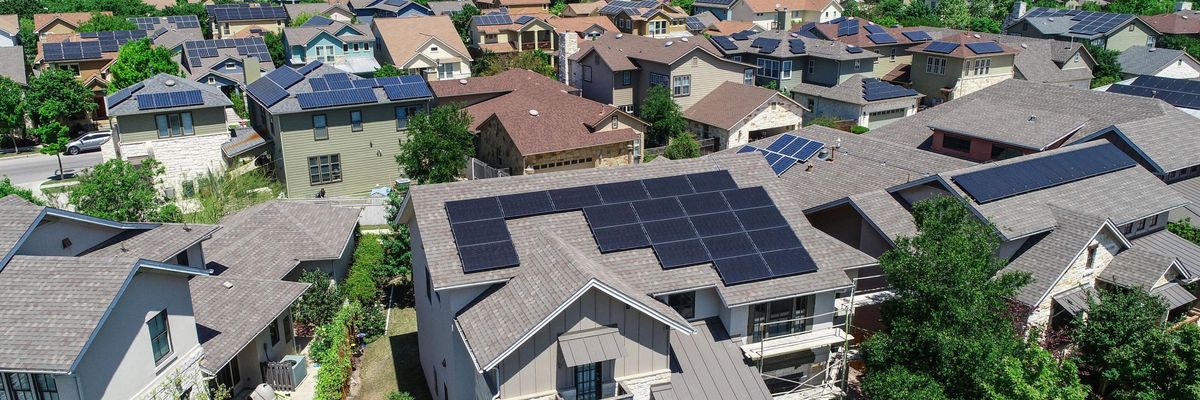A year after deadly winter weather swept through Texas, leaving residents without electricity, food, and water, an analysis published Thusday revealed how rooftop solar could have helped save lives during the nearly two-week crisis that killed at least 246 people.
"Solar is clean, more affordable than ever, and primed to help build a more resilient electric grid."
Most Texans rely on the state's isolated and underregulated power grid--which was no match for the unusually cold temperatures, freezing rain, sleet, and snow that hit last February, leading to widespread outages that fueled calls for a more resilient system.
The new paper from Environment America Research & Policy Center, Environment Texas Research & Policy Center, and Frontier Group notes that "the impacts of these power losses were nothing short of catastrophic," citing the death toll and estimates that "damages totaled as much as $195 billion."
"While gas- and coal-fired power plants, wind turbines, solar facilities, and nuclear power stations all contributed to reduced power generation during the freeze, gas failures led to the largest gaps in power supply," the report highlights. "Gas-fired generating units made up 55% of all unplanned outages and derates by capacity."
The research groups use the Texas crisis as a case study to illustrate how small-scale, distributed solar could not only provide eletricity while cutting pollution and taking advantage of already-developed rooftops but also "relieve strain on the power grid during times of stress."
Although "solar power has grown 123-fold in Texas over the last decade, the state's vast solar potential remains largely untapped," and "tapping Texas's full rooftop solar potential would have made a world of difference" during the deep freeze, the paper emphasizes.
"Texas's technical potential for rooftop solar generation alone is 97,800 MW--more than 15 times the total installed capacity at the time of the 2021 power crisis," the report states.
According to the analysis:
There were 13 days during mid- to late February during which power production fell short of forecasted demand; On 11 of those days, rooftop solar could have supplied more than enough power to meet the daily shortfall in power demand, on aggregate. And, during the two days when the gap between supply and demand was greatest... rooftop solar could still have made up between 40%-60% of the gap.
"Even as millions of Texans, including my family, shivered in the cold last February, the sun was shining over our heads," Luke Metzger, executive director of Environment Texas Research & Policy Center, said Thursday.
"We have this inexhaustible energy source above us that could have kept the heat on and we're barely using it--that just doesn't make sense," he added. "Solar is clean, more affordable than ever, and primed to help build a more resilient electric grid."
Though the report draws attention to the wasted potential of Texas rooftops, it also acknowledges some progress since early last year.
When the 2021 storm hit, "a total of 6,349 MW of solar capacity was installed on Texas rooftops or in utility-scale installations," the paper says. The state "entered the winter of 2022 with significantly greater solar capacity to meet this winter's challenges."
"The amount of installed utility-scale generating capacity in the Electric Reliability Council of Texas (ERCOT) region--which covers about 90% of the state's grid by electric load--was 76% higher at the end of January 2022 than it was at the beginning of January 2021," the report continues. "And the amount of small-scale solar capacity was 31% higher at the end of 2021 than it was at the end of 2021's first quarter."
"As a result," the paper adds, "Texas would now produce approximately 70% more solar electricity than it did a year ago under the same conditions as the February 2021 freeze event--increasing the benefit solar delivers to the environment and the grid."
Asserting that the 2021 freeze "offered a reminder of the fragility of the energy systems that most Americans depend on," the report concludes that "rooftop solar is a key building block of a cleaner, greener, more resilient energy future."
Emma Searson, director of Environment America Research & Policy Center's 100% Renewable Campaign, echoed those messages in a statement.
"The energy system of today is vulnerable and that puts all of us at risk," she said. "But the good news is that we have an amazing, abundant clean energy source shining down on our homes and businesses that can help us fix it."
"Rooftop solar is a win-win for people and the planet," Searson added, "and it has the potential to be a foundational building block of the resilient, renewable grid of tomorrow--in Texas and across the country."

